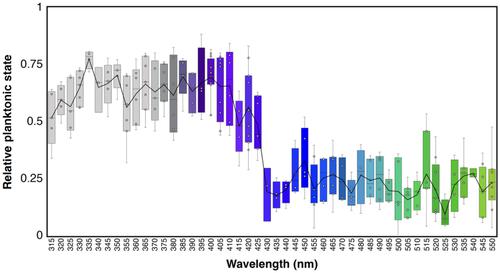当前位置:
X-MOL 学术
›
Ecol. Evol.
›
论文详情
Our official English website, www.x-mol.net, welcomes your feedback! (Note: you will need to create a separate account there.)
Larval swimming in the sea anemone Nematostella vectensis is sensitive to a broad light spectrum and exhibits a wavelength‐dependent behavioral switch
Ecology and Evolution ( IF 2.6 ) Pub Date : 2024-04-16 , DOI: 10.1002/ece3.11222 Emma Lilly 1 , Meghan Muscala 1 , Camilla R. Sharkey 1 , Kyle J. McCulloch 1
Ecology and Evolution ( IF 2.6 ) Pub Date : 2024-04-16 , DOI: 10.1002/ece3.11222 Emma Lilly 1 , Meghan Muscala 1 , Camilla R. Sharkey 1 , Kyle J. McCulloch 1
Affiliation

|
In nearly all animals, light‐sensing mediated by opsin visual pigments is important for survival and reproduction. Eyeless light‐sensing systems, though vital for many animals, have received relatively less attention than forms with charismatic or complex eyes. Despite no single light‐sensing organ, the sea anemone Nematostella vectensis has 29 opsin genes and multiple light‐mediated behaviors throughout development and reproduction, suggesting a deceptively complex light‐sensing system. To characterize one aspect of this light‐sensing system, we analyzed larval swimming behavior at high wavelength resolution across the ultraviolet and visual spectrum. N. vectensis larvae respond to light at least from 315 to 650 nm, which is a broad sensitivity range even compared to many animals with complex eyes. Planktonic swimming is induced by ultraviolet (UV) and violet wavelengths until 420 nm. Between 420 and 430 nm a behavioral switch occurs where at wavelengths longer than 430 nm, larvae respond to light by swimming down. Swimming down toward the substrate is distinct from light avoidance, as animals do not exhibit positive or negative phototaxis at any wavelength tested. At wavelengths longer than 575 nm, animals in the water column take increasingly longer to respond and this behavior is more variable until 650 nm where larval response is no different from the dark, suggesting these longer wavelengths lie outside of their sensitivity range. Larval swimming is the only motile stage in the life history of N. vectensis , and increased planktonic swimming could lead to greater dispersal range in potentially damaging shallow environments with short‐wavelength light exposure. Longer wavelength environments may indicate more suitable substrates for metamorphosis into the polyp stage, where the individual will remain for the rest of its life. Future work will test whether this robust behavior is mediated by multiple opsins.
中文翻译:

海葵 Nematostella vectensis 中游泳的幼虫对宽光谱敏感,并表现出波长依赖性行为开关
在几乎所有动物中,视蛋白视觉色素介导的光感应对于生存和繁殖都很重要。无眼光传感系统虽然对许多动物至关重要,但与具有魅力或复杂眼睛的系统相比,受到的关注相对较少。尽管海葵没有单一的感光器官维氏线虫 具有 29 个视蛋白基因,在整个发育和繁殖过程中具有多种光介导的行为,这表明它具有看似复杂的光传感系统。为了表征这种光传感系统的一个方面,我们分析了紫外线和可见光谱中高波长分辨率的幼虫游泳行为。维氏猪笼草 幼虫对至少 315 至 650 nm 的光有反应,即使与许多具有复杂眼睛的动物相比,这个敏感范围也很宽。浮游游泳是由紫外线 (UV) 和紫光波长(直至 420 nm)诱导的。在 420 至 430 nm 之间,会发生行为转换,波长超过 430 nm 时,幼虫会通过向下游动来响应光。向基底游动与避光不同,因为动物在任何测试的波长下都不表现出正或负的趋光性。在波长超过 575 nm 的情况下,水体中的动物需要越来越长的时间做出反应,并且这种行为变化更大,直到 650 nm,幼虫的反应与黑暗没有什么不同,这表明这些较长的波长超出了它们的敏感范围。幼虫的游泳是其生命史中唯一能运动的阶段维氏猪笼草 ,并且浮游游泳的增加可能会导致在短波长光暴露的潜在破坏性浅水环境中更大的扩散范围。较长的波长环境可能表明更适合变态为息肉阶段的基质,个体将在其余生中保持在该阶段。未来的工作将测试这种稳健的行为是否是由多种视蛋白介导的。
更新日期:2024-04-16
中文翻译:

海葵 Nematostella vectensis 中游泳的幼虫对宽光谱敏感,并表现出波长依赖性行为开关
在几乎所有动物中,视蛋白视觉色素介导的光感应对于生存和繁殖都很重要。无眼光传感系统虽然对许多动物至关重要,但与具有魅力或复杂眼睛的系统相比,受到的关注相对较少。尽管海葵没有单一的感光器官



























 京公网安备 11010802027423号
京公网安备 11010802027423号